More than nine years of data on UK smartphones means we can forecast how many people might stick with 'featurephones' - like the popular Nokia 6310 - and when the smartphone boom will be over
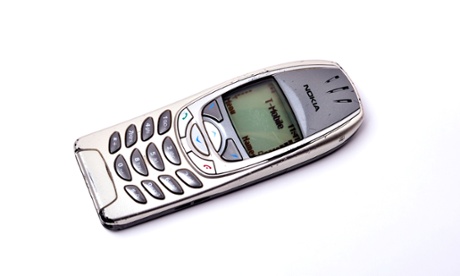
But in the intervening years, it now seems like everyone has got one, and what was unusual has become commonplace. Not just that, but that the number of people who have switched from an old "featurephone" to a smartphone has accelerated in the past few years.
It's true: that's what has happened. In the UK (and US, and other countries), smartphones are approaching "saturation" - the point where there are no new users to be converted to using them.
But when is saturation going to occur? And how many people will it involve? Thanks to data shared exclusively with the Guardian by Kantar ComTech, we can look at how the proportion of people with smartphones has grown over time - and make some predictions about when, and at what level, "saturation" will be reached.
Kantar ComTech's data goes back to October 2004 (when smartphone ownership was a dramatic 1.6%) and is gathered from a representative panel of users.
Presently, about 71% of UK consumer phone users have a smartphone, according to Kantar's data, and 84% of phones sold are ranked as "smart". (From which you can infer that featurephone owners are less regular buyers.)
But will that turn to 100%? How big is "saturation"?
The adoption of most technologies follows what is called the "logistic function" - an S-shaped curve that is mathematically related to the more familiar "
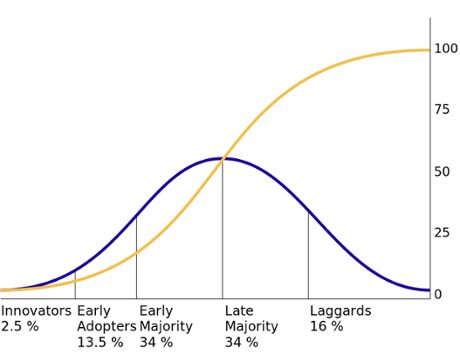
Given a dataset, you can fit it to a forecast. There are two ways to do this: one is to use a generator such as Areppim's S-curve calculator, feeding it various data points and trying to get the best fit. I did this a number of times, as below:
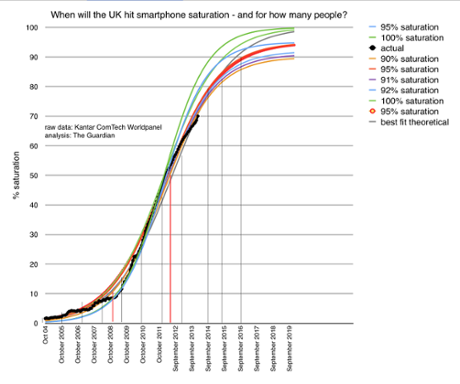
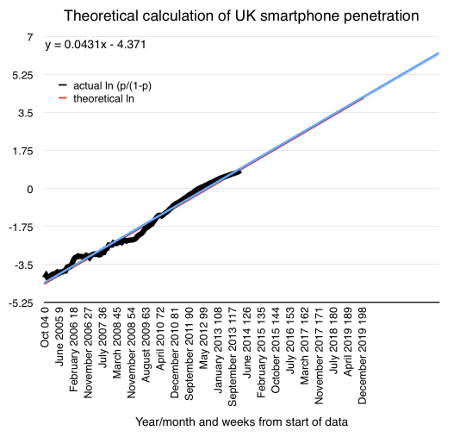
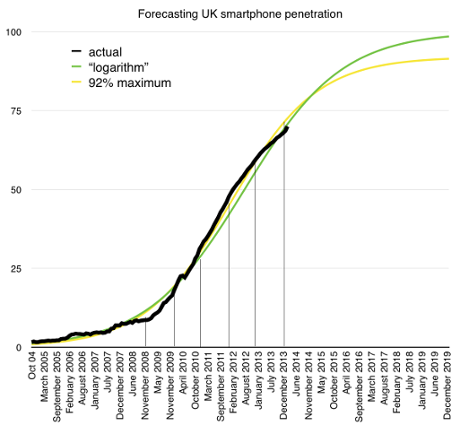
What does Kantar think? Dominic Sunnebo, its research director who provided the data, says that there are definitely a number of smartphone holdouts who will remain that way for a long time. The graph below graph shows the answers of this group (featurephone owners) to the question: "Do you plan to buy a Smartphone when you change your mobile?" conducted by Kantar:
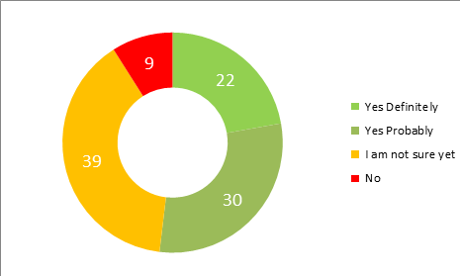
Separately, Dediu has done similar calculations for the US, using publicly available data from ComScore. He's forecasting that the US will hit 90% penetration of smartphones by adults over 13 for their own choice of phone by December 2016.
Contract and PAYG
But who are the smartphone holdouts? Are they refuseniks, or featurephone sticklers? According to data from the mobile operators, most featurephone users are on pay-as-you-go plans. The contrast between contract customers and PAYG customers in terms of smartphone penetration is marked.At the end of 2013:
• At EE, the UK's largest operator with 26 million subscribers, 90% of contract customers had smartphones; but they make up only 60% of its customers
• At O2, with 23.6 million subscribers, (54% on contract), smartphone penetration was 49% overall
• At Vodafone, 77% of contract subscribers have smartphones; but they're only 40.5% of the total - most of its customers are PAYG
• At Three, 94% of all its phone customers are on smartphones (though it is the UK's smallest operator)
Disagreeing with data
However it's worth remembering that theoretical forecasts are just that - theoretical. As the graph shows, the actual data doesn't always agree with what theory suggests - and that's because of obvious external factors.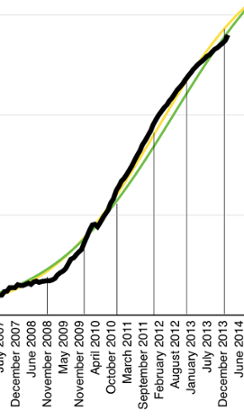
By contrast, in the next four years - 2009, 2010, 2011 and 2012 - actual penetration was ahead of theory, bolstering the idea that there's a "Christmas effect".
Yet 2013 shows the black line (actual data) falling behind the theory again. And data from GfK shows that the phone market is actually shrinking - and has been doing so, apart from the occasional uplift, for some time. GfK's data comes from retailers - 67,000 in all - and so gives a broad picture of what's happening.
On that basis, it's possible that the featurephone holdouts will be with us for much longer.
But the other effect, which I wrote about on Sunday, is that as saturation approaches, the nature of competition changes.
In theory, when you hit saturation, the size of the market should peak - because the whole population is a potential buyer, rather than a segment of it. But the reality is that not everyone renews at the same rate; as with featurephones, some people will stick with an ageing handset until it dies.
That means that to sell more smartphones, other elements - such as price (lower being better) or really compelling new features - become more important.
It will also mean that for any OS platform to expand its user base, another will have to lose. When I asked mobile operators whether they were seeing any evidence of this happening yet, they said they weren't.
Forthcoming: platform wars, again
In general, though, there's a simple trend: featurephone owners who get a smartphone tend to buy an Android phone; BlackBerry users who change platform tend to move to to an iPhone. Windows Phone users tend to come from capturing featurephone users.But what about the two main platforms? There's a growing body of evidence from the US and UK that iPhone users are more likely to remain on the platform than Android users, which mean that Android's lead is expected to erode slowly (because it has a larger user base, and is "leakier"). It's notable that Apple's chief executive Tim Cook said that the iPhone 5C - derided by many as a "flop" - had been successful in pulling in Android users:
I think it’s important to point out that if you look at some of the numbers we’re seeing on first-time iPhone buyers, people that bought the iPhone 4S, 85% were first-time iPhone buyers, and the 5C, 69% first-time iPhone buyers. So these are extraordinary, and as you would expect, these are also heavily Android switchers. 62% of the people that bought the 4S switched from Android; 60% of the people that bought the 5C switched from Android.It's worth noting too that according to industry data seen by the Guardian, in the contract market the iPhone 5C was the second best-selling phone in the UK in December; the iPhone 4S was the third best-selling. In January, the 4S and 5C swapped between second and third place.
By contrast, there's no reliable data suggesting that iPhone users are migrating to other platforms in significant numbers. The growth in Android seems largely generated by migration from featurephones.
That's certainly visible in the PAYG market, where smartphones are now 58% of sales and expected to hit 75% by the end of 2014. Notably, iPhones didn't appear in the top five PAYG handsets in December or January; Nokia (with its Lumia 520 and Nokia 100 featurephone), Samsung (with the Galaxy Fame - "a small, cheap phone aimed at younger users" according to TechRadar - and Galaxy Y, launched in August 2011, which TechRadar says "looks to bring functionality to the low-end range") and Huawei ("yet another under-the-radar, budget handset", says TechRadar).
But that's the reality as the market shifts - and also helps explain why Android dominates in countries where PAYG is the more common method of paying for handsets: contracts tend to obscure the full cost of the handset. However, the trend that mobile operators seem to be following in the UK at least is towards having more people on contracts. More of those, however, seem to be "SIM-only" contracts, which means that customers will have to pay the handset price. That certainly carries risks for companies selling expensive handsets, of which Apple is the prime example.
The other question that might also begin to matter is: where will the featurephone holdouts buy their phones from? The number of manufacturers offering them is dwindling: Samsung is shifting its phone lineup towards all smartphones, while Nokia has sold off its mobile division to Microsoft, and was seeing falling sales of its featurephones. And at the same time, smartphone prices are falling. It may be that the featurephone holdouts will find themselves owning a smartphone at some point after all - but they just won't use it that way.

No comments:
Post a Comment